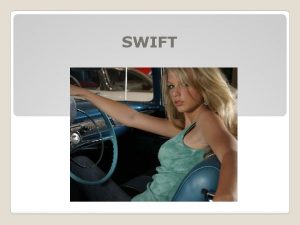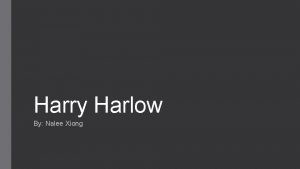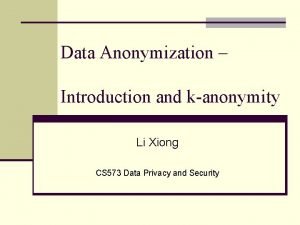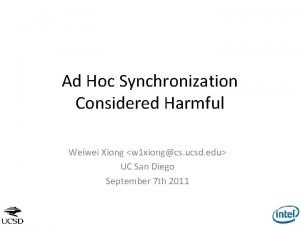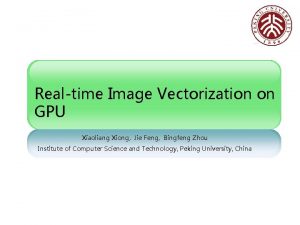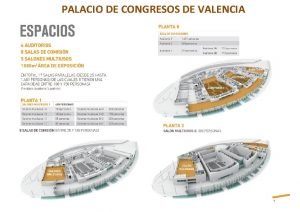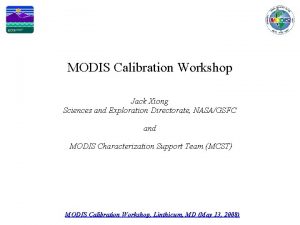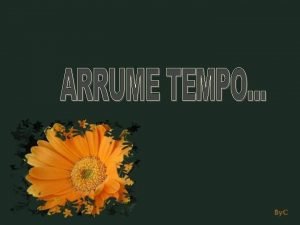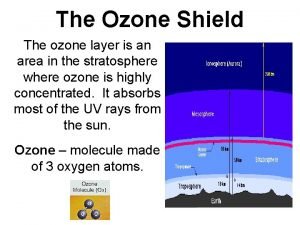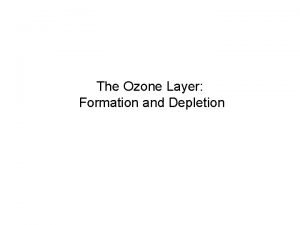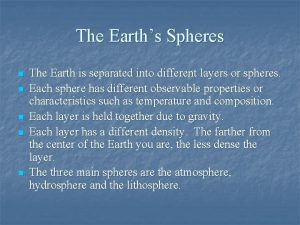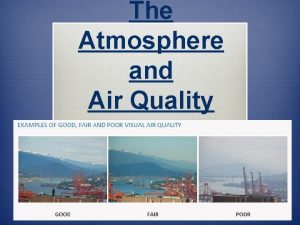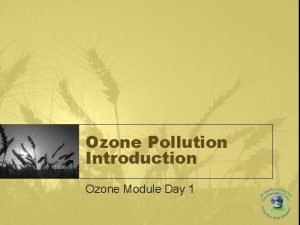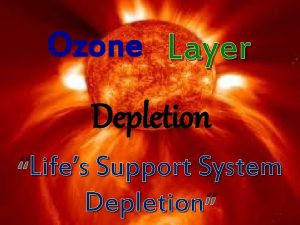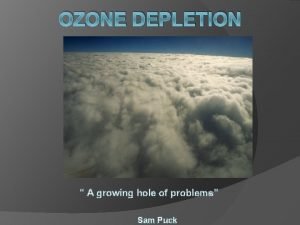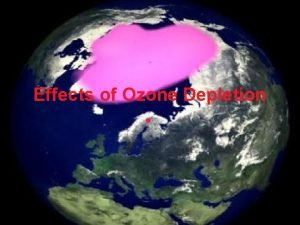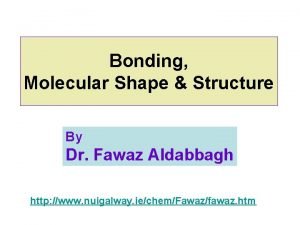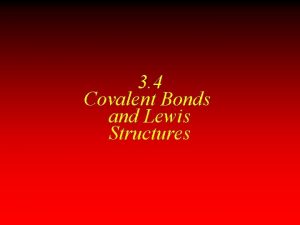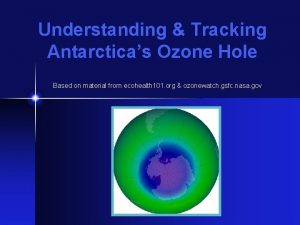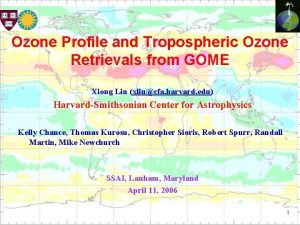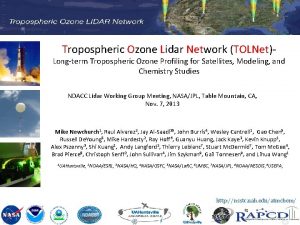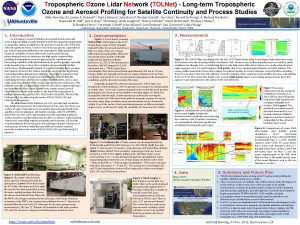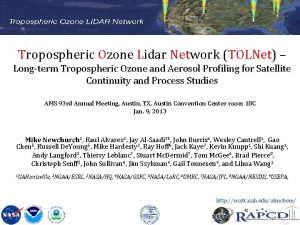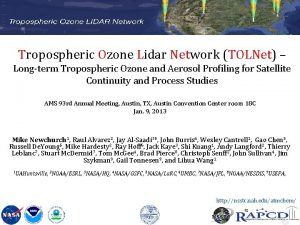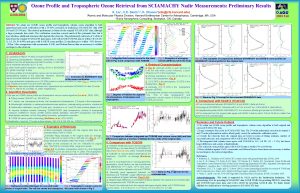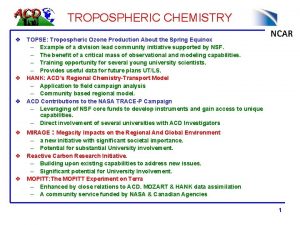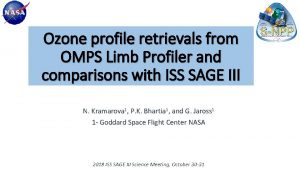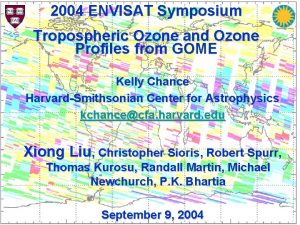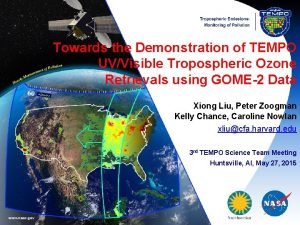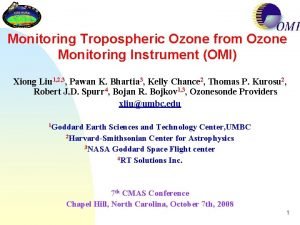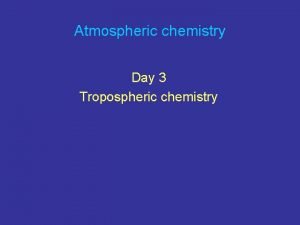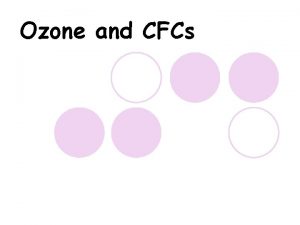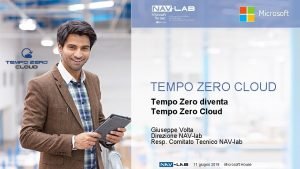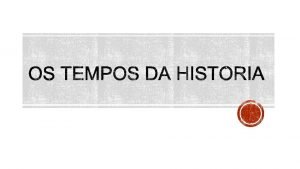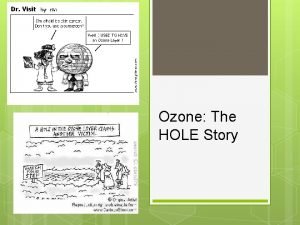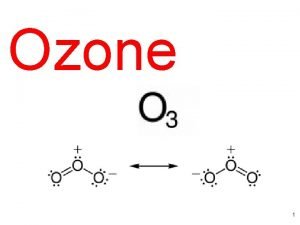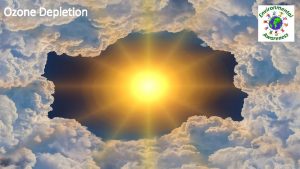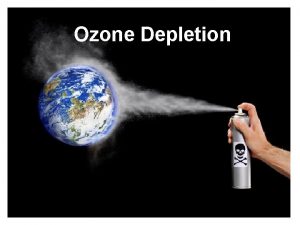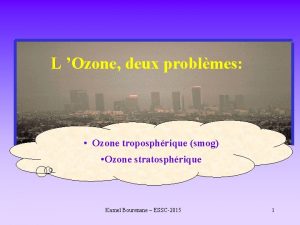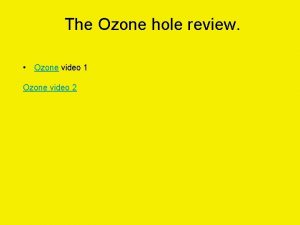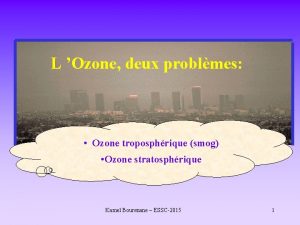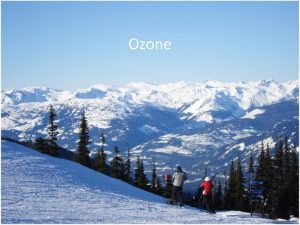TEMPO Ozone Profile and Tropospheric Ozone Retrievals Xiong



























- Slides: 27

TEMPO Ozone Profile and Tropospheric Ozone Retrievals Xiong Liu and Kelly Chance July 23, 2013 xliu@cfa. harvard. edu

Outline Introduction Ozone Profile and Tropospheric Ozone Algorithm: current implementation (OMI) and its adaption to TEMPO Preliminary GOME-2 UV + Visible O 3 Profile Retrieval Algorithm Updates for TEMPO Summary 9/29/2020 Document Title 2

Introduction BUV O 3 profile technique (Singer & Wentworth, 1957): applied to BUV, SBUV/2 since 1970 s (Mateer, 71, Bhartia et al. , 1996, 2013): vertical info. limited to > 20 -25 km + O 3 column below 25 km. Tropospheric O 3 retrieval is often done using residual-based approaches (e. g. , Fishman et al. , 1987). Chance et al. (1997): possible to extend to the troposphere from backscattered UV/Vis. spectra. Retrievals of O 3 profile including tropospheric O 3 from UV by GOME, GOME-2, OMI (e. g. , Munro et al. , 1998, Liu et al. , 2005, 2010; Cai et al. , 9/29/2020 Document Title 3

Introduction Vertical discrimination is primarily due to wavelengthdependent photon penetration (O 3 cross section + scattering) Additional tropospheric O 3 information from temperature dependence in the Huggins bands. Sensitivity to lower tropospheric O 3 from UV is still limited. GEO-CAPE and TEMPO STM: measure 0 -2 km and free tropospheric O 3 with retrieval errors 10 ppbv. 9/29/2020 Document Title 4

Introduction Multispectral retrievals: Combine UV with Vis. and/or TIR can greatly improve sensitivity to 0 -2 km O 3 (Natraj et al. , 2011). TEMPO: UV + Visible, driver for the visible channel (~540 -740 nm). Visible retrievals: demonstrated to improve tropospheric O 3 column from SCIAMACHY data by neural network algorithms (Sellitto et al. , TGRS, 2012; JQSRT, 2012). (a) UV (b) VIS (e) UV+TIR 9/29/2020 Document Title (c) TIR (d) UV+VIS (f) UV+VIS+TIR 5

Ozone Profile and Tropospheric O 3 Retrieval: Algorithm Description Applied to GOME (1995 -2003, Liu et al. , 2005), OMI (2004 -present, Liu et al. , 2010), GOME-2 (Cai et al. , 2012) OMI: implemented in and processed with OMI SIPS, adapted to TEMPO Spectral fitting + VLIDORT + Optimal Estimation (Rodgers, 2000) Fitting windows: 290 -307, 325 -340 nm (GOME), 270 -330 nm (OMI), 290 -340, 540 -650 nm (TEMPO) Retrieve O 3 partial columns at 24 layers from surface to above 60 km. , and derive total, stratospheric, and tropospheric O 3 columns. Add more layers to the troposphere for TEMPO. Ill-posed problem: OE with O 3 profile climatology (Mc. Peters et al. , 2007, Bak et al. , 2013) and measurement errors to constrain retrievals 9/29/2020 Document Title Y: Measurement (e. g. , radiances) X, Xi+1: State vector (e. g. O 3) Xa: a priori state vector K: Weighting function matrix, sensitivity of radiances to ozone Sa: A priori covariance matrix Sy: Measurement error cov. (SNR) 6

Examples of Ozone Profile (GOME, Oct. 22, 1997) 4/6/13 Ozone hole 9/29/2020 Biomass burning over Indonesia Document Title 7 7

Examples of Tropospheric O 3 Column (GOME, Oct. 22 -24, 1997) 4/6/13 contrast in the tropics Zonal 9/29/2020 Biomass burning over Indonesia 8 Document Title 8

Ozone Profile and Tropospheric O 3 Retrieval: Algorithm Description Keys to successful retrievals: accurate wavelength/radiometric calibration, forward model simulations Fitting residuals better than 0. 1 -0. 2% 9/29/2020 Document Title in longer UV, and visible 9

High Resolution Solar Reference Spectrum 0. 01 nm with accurate to 0. 002 nm Wavelength/slit function calibration, undersampling correction, Ring effect (Chance et al. , 1997, 2005, 2010; Chance, 1998) 9/29/2020 Document Title 10

Slit and Wavelength Calibrations Accurate slit function and wavelength calibration are critical. TEMPO ISD requires small bandpass asymmetry, spectral variation. Ball will provide pre-launch characterization. The algorithm is capable of characterizing slit function/wavelength registration (vs. wavelength and time) (Liu et al. , 2005; Cai et al. , 2012). Fitting includes wavelength shifts between radiance/irradiances, radiances and O 3 cross sections Document Title 9/29/2020 11

Radiometric Calibration Wavelength and across-track dependent soft calibration for OMI derived using a few days of zonal mean MLS + trop. O 3 climatology Empirical soft calibration: RTM with correlative O 3 dataset TEMPO: polarization sensitive (unlike OMI) without PMDs (unlike GOME, SCIA. , and GOME-2), correction of instrument polarization sensitivity combing laboratory characterization and look-up table of polarization state, fitting residual polarization structures 9/29/2020 Document Title 12

Forward Model Simulation VLIDORT (Spur, 2006) with approximations to speed up calculations (limited # of streams, layers, mostly scalar) Clouds: Lambertian +IPA, Pcld from cloud products, derive fc from nonabsorbing wavelengths (e. g. , 347 nm for OMI). Other cloud models might be explored for TEMPO. Aerosols: capable of being simulated with CTM climatology, but typically not included. Might consider retrieving AOD for TEMPO. Surface albedo: initialized from an albedo database, fit -dependent polynomial (1 st order). Might fit scaling parameters for different surface albedo spectra in the visible for TEMPO. O 3 profile: initialized from clima. /previous retrievals, iteratively updated Other trace gases: climatological profiles from CTMs, fit VCDs Auxiliary data: meteorological temperature profiles, surface and tropopause pressure. Ring effect: directly model the 1 st-oder RRS of the direct beam, including dependence on T and telluric absorption) (Sioris and Evans, 2001) 9/29/2020 Document Title 13

Ozone Profile and Tropospheric O 3 Retrieval: Algorithm Description 9/29/2020 Document Title 14

Retrieval Characterization: Vertical Information (OMI) Well resolved in the stratosphere with ~7 -10 km FWHM over 15 -45 km and ~10 -14 km in the troposphere. Significant retrieval interferences from other auxiliary parameters in the lower troposphere, otherwise: effectively sensitive to ozone at 900 -950 h. Pa. 9/29/2020 Document Title 15

Retrieval Errors (OMI) Random-noise (R) errors: 0. 5 -2% in the middle strat. , generally within 10% below Solution (R+S) errors at each ~2. 5 km layer: 1 -6% in the middle strat. , generally up to 10% in the upper stratosphere, generally within 6 -35% in the lower stratosphere and troposphere 9/29/2020 Document Title 16

Retrieval Errors (OMI) 2006 m 0711 Errors (SZA < 80°): TOZ: 0. 5 -3 DU (R+S), OMTO 3 and OMDOAO 3 errors are a few times larger SOC: 1. 5 -4 DU (R+S), better than limb measurements (e. g. , MLS on Aura) TOC: 2 -5 DU (R+S) 9/29/2020 Document Title 17

Tropopause-Based (TB) Ozone Profile Climatology Bak et al. (2013, AMT, in press) developed a TB O 3 profile climatology: use tropopause to significantly improve a priori knowledge for within a few km around tropopause. Improve retrievals of UT/LS ozone and free tropospheric ozone in the extratropics. 9/29/2020 Document Title 18

Retrieval Improvement with the TB Climatology Capture much better horizontal & vertical gradient over UT/LS, reduce smoothing from LS to the UT Significantly reduce retrieval errors in the UT/LS 9/29/2020 Document Title 19

OMI Validation with Ozonesonde Collocation with ozonesonde data (2004 -2008): < 6 hours, 1º lon. /lat. , cloud fraction < 0. 3. After removing smoothing errors (i. e. , AKs applied), OMI agrees well with ozonesonde to within 5 -10%, with standard deviations within ~1525%. 9/29/2020 Document Title 20

OMI Validation with Ozonesonde Good agreement for surface-200 h. Pa TCO: 0. 4± 5 -6 DU, r~0. 8, slope~0. 7. Small biases (<5% or 1 DU) for srfc-2. 5/5 km comp. , but correlation/slope decrease for comparison at lower altitudes due to reduced sensitivity. Much better comparison (slope: 0. 84 -0. 9, correlation: 0. 86 -0. 9) with OMI AKs. 9/29/2020 Document Title 21

Preliminary GOME-2 UV + Visible Retrievals 4 channels: 289 -307, 315 -340, 500 -595, 602 -646 nm Additional Fitting: O 2 O 2, H 2 O, O 2, vegetation and chlorophyll spectra, common mode Surface albedo: 4 rd-order in Visible 9/29/2020 Document Title 22

Preliminary GOME-2 UV + Visible Retrievals Fitting RMS, 0. 05 -0. 1% in UV-2 b, 0. 03 -0. 05% in the visible. 9/29/2020 Document Title 23

Preliminary GOME-2 UV+Visible Fitting Residuals Relative large fitting residuals over the ocean, indicating ocean color is not well modeled. The ability to reduce the fitting residuals in the visible over land to ~0. 05% is very encouraging. Identified some pixels collocated with ozonesonde, which has DFS increase of 0. 15 -0. 2, but the retrievals are still subject to further analysis and optimization. 9/29/2020 Document Title 24

Algorithm Updates for TEMPO (1) Reduce the interferences from surface albedo/aerosols, improve both UV, UV+Visible retrievals. Improve surface spectral albedo database especially in the visible (e. g. , high spatial resolution MODIS surface albedo database + ASTER albedo spectra). Explore the feasibility to fit several surface albedo spectra in the visible (e. g. , vegetation, soil, water) Retrieve aerosol information (e. g. , AOD) to reduce the interferences and improve the surface treatment using auxiliary aerosol information from model fields or additional TEMPO bands to provide more information. 9/29/2020 Document Title 25

Algorithm Updates for TEMPO (2) Speed up ozone profile processing: the on-line radiative transfer calculations and the large spectral range Perform retrievals at 8× 4. 5 km 2 (rather than 2× 4. 5 km 2 for other species) Working with Rob to speed up RTM calculations, combining Ø Scalar VLIDORT calculation with look up tables (LUTs) to correct for the neglect of polarization in RTM on radiances and provide knowledge of polarization state for correcting instrument polarization sensitivity Ø Fast codes: linearized two orders of scattering (2 OS) or linearized two streams with LUTs for correction (Natraj, Spurr et al. , 2007) Ø Principal Component Analysis (PCP) analysis of optical inputs to speed up the RTM calculations 9/29/2020 Document Title 26

Summary TEMPO will combine UV and visible measurements to improve retrieval sensitivity to lower tropospheric ozone and meet the TEMPO requirements. We will adapt our OMI ozone profile retrieval algorithm (currently working with UV only) to TEMPO, with algorithm updates to Improve the UV + Visible from existing satellite/aircraft data by improving the surface albedo/aerosol treatment and reduce their interferences Speed up processing by combining fast approximation codes with LUTs for corrections. 9/29/2020 Document Title 27
 Society of worldwide interbank financial telecommunication
Society of worldwide interbank financial telecommunication An unforgettable journey story
An unforgettable journey story Alonzo harlow israel
Alonzo harlow israel Vong xiong
Vong xiong Li xiong
Li xiong Weiwei xiong
Weiwei xiong Xiong jie
Xiong jie Ning yun wu xiong
Ning yun wu xiong Nadsvd
Nadsvd Hmong shaman tools
Hmong shaman tools Arrume tempo para quem tem tempo pra você
Arrume tempo para quem tem tempo pra você Perdemos tempo no tempo
Perdemos tempo no tempo Negative effects of ozone depletion
Negative effects of ozone depletion How do cfcs destroy ozone
How do cfcs destroy ozone Protective ozone layer
Protective ozone layer Ozone composition
Ozone composition Sopmed ozone
Sopmed ozone Microplasma ozone
Microplasma ozone Protective ozone layer
Protective ozone layer Ozone layer depletion
Ozone layer depletion Ozone layer simple definition
Ozone layer simple definition Ozone blanket
Ozone blanket Lewis structures cannot
Lewis structures cannot Chemical sensitivity symptoms
Chemical sensitivity symptoms Ozone depletion effects on humans
Ozone depletion effects on humans Nh4 + molecular geometry
Nh4 + molecular geometry Methyl nitrite lewis structure
Methyl nitrite lewis structure Causes of the ozone depletion
Causes of the ozone depletion
